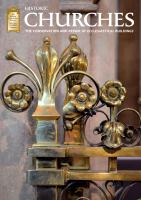

BCD SPECIAL REPORT ON
HISTORIC CHURCHES
22
ND ANNUAL EDITION
17
We can quickly identify biblical scenes
such as the Nativity and the emblems
of major saints, such as St Catherine’s
wheel. Symbols of the Trinity or Passion
are less well known perhaps, but is there
a message in the small-scale figures,
faces and creatures too? While literacy
increased in the Middle Ages, the great
majority of people entering a church
would not have been able to read (and
in any case, any script was most likely
to be in Latin before the 16th century).
Medieval people certainly recognised
many more scenes from the Bible than
modern churchgoers, but there were
plenty of other sources of inspiration
for painted and carved decoration.
Hagiographical stories were also widely
used to convey Christian messages.
Morality tales like the Three Dead Kings
were also widely known, not least through
the plays regularly performed by travelling
actors and troubadours.
Although we may have over-
romanticised the imagery of church wall-
paintings and windows as the poor man’s
Bible, there is no doubt that a church
building of whatever scale or pretension
was full of meaning to everyone who
entered it. Unfortunately, very few wrote
down their thoughts. However, we do
know a little more from the work of
William Durandus who died in Rome
in 1296. A canon lawyer with a long
Papal career, Durandus became Bishop
of Mendes, in the south of France. His
book
Rationale Divinorum Officiorum
describes the origins and symbolism of
churches and their ornaments in some
detail. He explains that ‘the material
modern churchgoers and visitors might
feel that using pagan, satirical, if not
downright rude sculpture on a church
is sacrilegious. While cathedral guides
might revel in stories about masons
hiding their little jokes from the foreman,
in the end someone paid for the work
and had an ulterior motive for doing
so. It may have been rare for patrons
like a bishop, abbot or earl to become
personally involved at such a detailed
level, but their project manager (with
whatever title he held) certainly would,
if only to ensure he wasn’t blamed if his
master disapproved of the work or its
cost. All we can be sure of is that the
medieval mason was working within
well-known traditions and to an overall
scheme. As today, it can be difficult to
attribute the precise source of an idea
to one member of the design team.
church, wherein the people assemble to
set forth God’s holy praise, symboliseth
that Holy Church which is built in Heaven
of living stones’. Other writers also allude
to church buildings as the House of God
representing heaven on earth. Given the
vast differences between churches and
people’s homes, it is not difficult to see
how this concept worked.
Durandus assigns attributes to
different parts of the building, often
linking them to quotations from the
Bible. So the foundation is Faith, ‘which
is conversant with unseen things’, the roof
Charity, ‘which covereth a multitude of
sins’ (1 Peter 4: 8), the door Obedience
and the pavement Humility, ‘my soul
cleaveth to the dust’ (Psalm 119: 25). The
glass windows ‘are the Holy Scriptures
which expel the wind and rain, that is
all things hurtful, but transmit the light
of the True Sun, that is God, into the
hearts of the Faithful. These are wider
within than without because the mystical
sense is the more ample and precedeth
the literal meaning.’ The latter is an
interesting comment on the practical use
of splays to admit more light through
thick walls but it also illustrates just how
differently medieval churchgoers saw
and understood religious architecture in
comparison to modern observers.
However, that concept of each church
being an earthly image of heaven readily
explains why roofs came to be extensively
decorated with angels, with their principal
timbers rising from corbels fronted by
angels holding the symbols of the Passion,
musical instruments or the coat of arms
of the patron. Such angel corbels become
Stone angel corbel at All Saints, Landbeach, Cambridgeshire
A jolly troubadour or merchant patron at All Saints, Harston, Cambridgeshire
Angel musician at St Wendreda, March,
Cambridgeshire
















